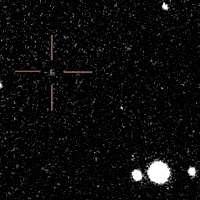 | |
| Discovery [1] | |
|---|---|
| Discovered by | C. S. Shoemaker E. M. Shoemaker |
| Discovery site | Palomar Obs. |
| Discovery date | 12 October 1985 |
| Designations | |
| (7167) Laupheim | |
Named after | Laupheim Observatory [1] (Robert Clausen and team) |
| 1985 TD3 · 1991 VR4 | |
| main-belt [1][2] · (outer) background [3] | |
| Orbital characteristics [2] | |
| Epoch 23 March 2018 (JD 2458200.5) | |
| Uncertainty parameter 0 | |
| Observation arc | 32.04 yr (11,702 d) |
| Aphelion | 3.7768 AU |
| Perihelion | 2.4740 AU |
| 3.1254 AU | |
| Eccentricity | 0.2084 |
| 5.53 yr (2,018 d) | |
| 280.23° | |
| 0° 10m 42.24s / day | |
| Inclination | 23.495° |
| 219.57° | |
| 181.55° | |
| TJupiter | 3.0550 |
| Physical characteristics | |
Mean diameter | 17.86 km (calculated)[4] 17.95±5.00 km[5] 20.03±0.78 km[6] 23.229±0.258 km[7][8] |
| 7.040±0.0040 h[9] | |
| 0.057±0.011[7][8] 0.057 (assumed)[4] 0.058±0.005[6] 0.08±0.06[5] | |
| C (assumed)[4] | |
| 11.9[8] 12.00[5] 12.019±0.002 (R)[9] 12.1[2] 12.23±0.23[10] 12.30[6] 12.47[4] | |
7167 Laupheim, provisional designation 1985 TD3, is a dark background asteroid from the outer regions of the asteroid belt, approximately 20 kilometers (12 miles) in diameter. It was discovered on 12 October 1985, by American astronomers Carolyn and Eugene Shoemaker at the Palomar Observatory in California. The presumed C-type asteroid has a rotation period of 7.04 hours and was named for Robert Clausen and his team at the public Laupheim Observatory in Germany.[1][4]
Orbit and classification
Laupheim is a non-family asteroid from the main belt's background population.[3] It orbits the Sun in the outer main-belt at a distance of 2.5–3.8 AU once every 5 years and 6 months (2,018 days; semi-major axis of 3.13 AU). Its orbit has an eccentricity of 0.21 and an inclination of 23° with respect to the ecliptic.[2] The body's observation arc begins at Palomar in September 1985, about a month before its official discovery observation.[1]
Physical characteristics
Laupheim is an assumed carbonaceous C-type asteroid.[4]
Rotation period
In October 2013, a rotational lightcurve of Laupheim was obtained from photometric observations by astronomers at the Palomar Transient Factory in California. Lightcurve analysis gave a rotation period of 7.040 hours with a brightness amplitude of 0.31 magnitude (U=2).[9]
Diameter and albedo
According to the surveys carried out by the Japanese Akari satellite and the NEOWISE mission of NASA's Wide-field Infrared Survey Explorer, Laupheim measures between 17.95 and 23.229 kilometers in diameter and its surface has an albedo between 0.057 and 0.08.[5][6][7][8]
The Collaborative Asteroid Lightcurve Link assumes a standard albedo for a carbonaceous asteroid of 0.057 and calculates a diameter of 17.86 kilometers based on an absolute magnitude of 12.47.[4]
Naming
This minor planet was named for Robert Clausen (born 1951) and his team at the public Laupheim Observatory (German: Volksternwarte Laupheim) in Laupheim, southern Germany.[1] It was named by the discoverer Carolyn Shoemaker who visited the observatory in 1998. Clausen founded an association of amateur astronomers in 1975 which organized traveling astronomical exhibitions and numerous international astronomy festivals. Since 1990, he and his co-workers have also been running a Zeiss planetarium.[1][11]
The official naming citation was published by the Minor Planet Center on 4 May 1999 (M.P.C. 34625).[12]
References
- 1 2 3 4 5 6 7 "7167 Laupheim (1985 TD3)". Minor Planet Center. Retrieved 13 April 2018.
- 1 2 3 4 "JPL Small-Body Database Browser: 7167 Laupheim (1985 TD3)" (2017-09-30 last obs.). Jet Propulsion Laboratory. Retrieved 13 April 2018.
- 1 2 "Asteroid 7167 Laupheim – Proper Elements". AstDyS-2, Asteroids – Dynamic Site. Retrieved 29 October 2019.
- 1 2 3 4 5 6 7 "LCDB Data for (7167) Laupheim". Asteroid Lightcurve Database (LCDB). Retrieved 13 April 2018.
- 1 2 3 4 Nugent, C. R.; Mainzer, A.; Masiero, J.; Bauer, J.; Cutri, R. M.; Grav, T.; et al. (December 2015). "NEOWISE Reactivation Mission Year One: Preliminary Asteroid Diameters and Albedos". The Astrophysical Journal. 814 (2): 13. arXiv:1509.02522. Bibcode:2015ApJ...814..117N. doi:10.1088/0004-637X/814/2/117.
- 1 2 3 4 Usui, Fumihiko; Kuroda, Daisuke; Müller, Thomas G.; Hasegawa, Sunao; Ishiguro, Masateru; Ootsubo, Takafumi; et al. (October 2011). "Asteroid Catalog Using Akari: AKARI/IRC Mid-Infrared Asteroid Survey". Publications of the Astronomical Society of Japan. 63 (5): 1117–1138. Bibcode:2011PASJ...63.1117U. doi:10.1093/pasj/63.5.1117. (online, AcuA catalog p. 153)
- 1 2 3 Masiero, Joseph R.; Mainzer, A. K.; Grav, T.; Bauer, J. M.; Cutri, R. M.; Dailey, J.; et al. (November 2011). "Main Belt Asteroids with WISE/NEOWISE. I. Preliminary Albedos and Diameters". The Astrophysical Journal. 741 (2): 20. arXiv:1109.4096. Bibcode:2011ApJ...741...68M. doi:10.1088/0004-637X/741/2/68.
- 1 2 3 4 Mainzer, A.; Grav, T.; Masiero, J.; Hand, E.; Bauer, J.; Tholen, D.; et al. (November 2011). "NEOWISE Studies of Spectrophotometrically Classified Asteroids: Preliminary Results". The Astrophysical Journal. 741 (2): 25. arXiv:1109.6407. Bibcode:2011ApJ...741...90M. doi:10.1088/0004-637X/741/2/90.
- 1 2 3 Waszczak, Adam; Chang, Chan-Kao; Ofek, Eran O.; Laher, Russ; Masci, Frank; Levitan, David; et al. (September 2015). "Asteroid Light Curves from the Palomar Transient Factory Survey: Rotation Periods and Phase Functions from Sparse Photometry". The Astronomical Journal. 150 (3): 35. arXiv:1504.04041. Bibcode:2015AJ....150...75W. doi:10.1088/0004-6256/150/3/75.
- ↑ Veres, Peter; Jedicke, Robert; Fitzsimmons, Alan; Denneau, Larry; Granvik, Mikael; Bolin, Bryce; et al. (November 2015). "Absolute magnitudes and slope parameters for 250,000 asteroids observed by Pan-STARRS PS1 - Preliminary results". Icarus. 261: 34–47. arXiv:1506.00762. Bibcode:2015Icar..261...34V. doi:10.1016/j.icarus.2015.08.007.
- ↑ "Planetoid 7167 Laupheim" (in German). Planetarium und Sternwarte – Volkssternwarte Laupheim e.V. Retrieved 13 April 2018.
- ↑ "MPC/MPO/MPS Archive". Minor Planet Center. Retrieved 13 April 2018.
External links
- Find 7167 Laupheim in the night sky
- Asteroid Lightcurve Database (LCDB), query form (info Archived 16 December 2017 at the Wayback Machine)
- Dictionary of Minor Planet Names, Google books
- Discovery Circumstances: Numbered Minor Planets (5001)-(10000) – Minor Planet Center
- 7167 Laupheim at AstDyS-2, Asteroids—Dynamic Site
- 7167 Laupheim at the JPL Small-Body Database